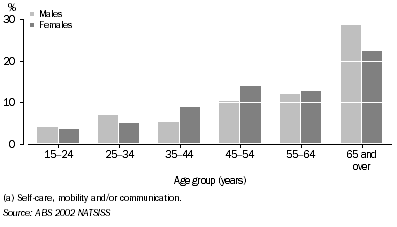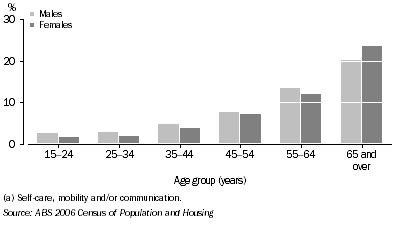COMPARISON OF 2006 CENSUS AND 2002 NATSISS DISABILITY MEASURES
The 2002 NATSISS included a short disability survey module comprising 12 questions (and associated prompt cards), and the 2006 Census need for assistance measure comprised a set of four questions - one for each of the core activity areas and an additional question to ascertain why assistance with core activities was needed (see ABS & AIHW 2005 and Appendix 1 of this report). In order to differentiate between the two measures, Indigenous people identified as meeting the criteria in the 2002 NATSISS are referred to as having a 'profound/severe core activity limitation' while in the 2006 Census, the corresponding population is referred to as 'needing assistance with core activities'. Results from the 2002 NATSISS and 2006 Census are based on relatable concepts, but are not suitable for direct comparison to provide an indication of change in the prevalence of disability over time.
Prevalence by age and sex
The following analysis is restricted to persons living in private dwellings (i.e. excludes people in nursing homes and other cared accommodation) with further age and geographic restrictions to align the populations measured in the 2006 Census, the 2002 NATSISS and the 2002 General Social Survey (GSS).
According to the 2006 Census, around one in 20 Indigenous people aged 15 years and over in private dwellings (5%) needed assistance with core activities. In comparison, the overall rate of profound/severe core activity limitation among Aboriginal and Torres Strait Islanders aged 15 years and over reported in the 2002 NATSISS was 8%. In both collections, the disability rate was higher in older age groups, ranging from 2% of those aged 15-24 years to 22% of those aged 65 years and over in the 2006 Census, and from 4% to 25% for the same age groups in the 2002 NATSISS.
The need for assistance rates from the 2006 Census were lower than the rates of profound/severe core activity limitation from the 2002 NATSISS for all groups apart from men aged 55-64 years and women aged 65 years and over, for whom survey and Census rates were similar (graphs 5.1 and 5.2). In interpreting other characteristics of people reporting need for assistance with core activities, or profound/severe core activity limitation, the differences in levels measured in the 2002 NATSISS and 2006 Census should be taken into account.
5.1 PROFOUND/SEVERE CORE ACTIVITY LIMITATION(a), Indigenous persons in private dwellings
- 2002

5.2 NEEDS ASSISTANCE WITH CORE ACTIVITIES(a), Indigenous persons in private dwellings
- 2006

Comparison with non-Indigenous people
The proportions of Indigenous and non-Indigenous adults with a profound/severe core activity limitation in non-remote areas are available from the 2002 NATSISS and 2002 GSS (table 5.3). When Indigenous and non-Indigenous age-specific rates are compared, the resulting rate ratio provides an indication of the relative prevalence of profound/severe core activity limitation in the two populations. For more information on the calculation of rate ratios, see the Glossary.
The Indigenous to non-Indigenous rate ratios, based on age-specific profound/severe core activity limitation rates from the 2002 NATSISS and 2002 GSS, indicate that Indigenous people were between one-and-a-half and three-and-a-half times as likely as non-Indigenous people to have a profound/severe core activity limitation. When differences in the age structure of the Indigenous and non-Indigenous populations were taken into account, Indigenous people overall were twice as likely as non-Indigenous people to have a profound/severe core activity limitation (table 5.3).
Similarly, Indigenous to non-Indigenous rate ratios from the 2006 Census indicate that Indigenous adults in non-remote areas were between one-and-a-half and three times as likely as non-Indigenous adults to need assistance with core activities. When differences in the age structure of the Indigenous and non-Indigenous populations were taken into account, Indigenous adults in non-remote areas were twice as likely as non-Indigenous adults to need assistance with core activities (table 5.3).
5.3 NEEDS ASSISTANCE AND PROFOUND/SEVERE CORE ACTIVITY LIMITATION, age-specific rates(a)(b) - 2006 and 2002 |
|  |
 | Needs assistance with core activities (2006 Census) | Profound/severe core activity limitation (2002 NATSISS and GSS) | Indigenous to Non-Indigenous rate ratios |  |
 | Indigenous | Non-Indigenous | Indigenous | Non-Indigenous | 2006 Census | 2002 NATSISS and GSS |  |
| Age group (years) | % | % | % | % | ratio | ratio |  |
|  |
| 18-24 | 2.5 | 1.3 | 3.6 | 1.8 | 2.0 | 2.0 |  |
| 25-34 | 2.8 | 1.2 | 6.8 | 2.2 | 2.3 | 3.1 |  |
| 35-44 | 4.9 | 1.7 | 7.5 | 4.0 | 2.8 | 1.9 |  |
| 45-54 | 8.2 | 2.7 | 12.4 | 3.5 | 3.1 | 3.5 |  |
| 55-64 | 13.2 | 4.8 | 11.0 | 5.9 | 2.8 | 1.9 |  |
| 65 and over | 20.2 | 13.4 | 20.2 | 12.7 | 1.5 | 1.6 |  |
| 18 and over | 6.1 | 4.2 | 8.1 | 4.9 | 1.5 | 1.7 |  |
| Total - Age standardised | 8.4 | 4.1 | 10.5 | 5.0 | 2.1 | 2.1 |  |
|  |
| (a) Persons aged 18 years and over, living in private dwellings in non-remote areas. |
| (b) These data do not represent change in prevalence over time. |
| Source: ABS 2006 Census of Population and Housing, 2002 NATSISS, 2002 GSS |
5.4 2006 CENSUS - CORE ACTIVITY NEED FOR ASSISTANCE
2006 Census - Need for assistance questions
The 2006 Census asked three questions about need for assistance with core activities of self-care, mobility and communication and then a further question about the reason(s) that help was needed. Responses to these questions were used to identify whether there was a Core Activity Need for Assistance (see Appendix 1). While conceptually consistent with the 'severe/profound core activity limitation' concept from the 2002 NATSISS, the Census criteria asked fewer questions to identify people with disability. Because of this, the number of people identified in the 2006 Census as needing assistance with core activities will generally be lower than comparable estimates of people with a profound/severe core activity limitation from the 2002 NATSISS (and other surveys using the standard short disability module).
Collection methodologies
While information in the 2002 NATSISS was collected via personal interview, Census data for more than three-quarters of the Indigenous population (77%) were provided by a household member filling in a Census form for themselves and/or on behalf of other usual household residents, without prompting or assistance. Data for 17% of Indigenous people (in discrete Indigenous communities) were collected via interview, on the Interviewer Household Form (IHF), and a further 5% (in non-private dwellings) were enumerated on a Personal Form which they may or may not have completed themselves.
Unlike household surveys, where missing values may be imputed using statistical techniques, Census data retain this non-response within separately identified 'not stated' categories, and this is a contributor to lower numbers of Indigenous people identified as needing assistance in the Census. In the Indigenous population, the non-response rate was 7% for the questions about need for assistance, and in the non-Indigenous population, non-response was 2%. |
 Print Page
Print Page
 Print All
Print All